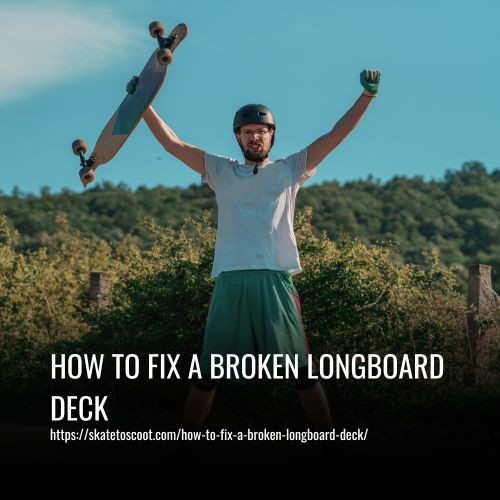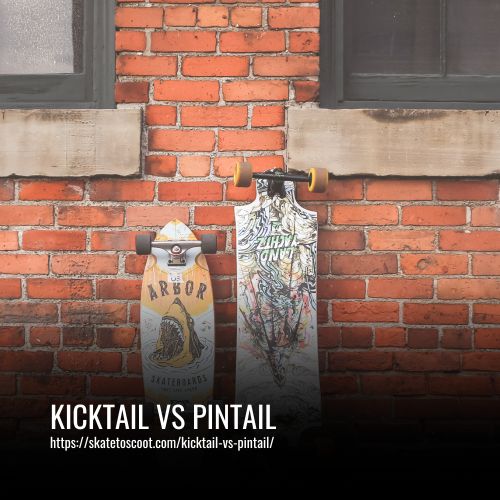As an Amazon Associate we earn from qualifying purchases.
Longboard decks can sometimes get damaged from wear and tear, accidents, or simply old age. When this happens, it’s important to know how to fix a broken longboard deck to get back on the road.
To Fix A Broken Longboard Deck, Follow These Steps:
Surface Crack Repair:
- Clean the Area:
- Fill the Crack:
- Sand the Surface:
- Apply a Protective Coating:
Structural Crack Repair:
- Assess the Damage:
- Reinforce the Crack:
- Apply Additional Layers:
- Sand and Finish:

How To Fix A Broken Longboard Deck: A Comprehensive Guide
Longboard decks are prone to cracks and damage over time. Fortunately, with the right tools and techniques, you can effectively fix these cracks and restore your longboard deck to its original shape and strength. Here’s a step-by-step guide on repairing cracks:
- Surface cracks: Superficial cracks that don’t affect the deck’s integrity.
- Structural cracks: Cracks that compromise the board’s strength and stability.
Surface Crack Repair:
1. Clean the Area:
- Use mild detergent and water to remove dirt and debris from the crack.
- Dry the area thoroughly.
2. Fill the Crack:
- To repair the crack, carefully spread a thin layer of epoxy resin, making sure to fill it completely.
- Smooth out the surface using a plastic scraper or putty knife.
3. Sand the Surface:
- Once the epoxy has completed its curing process, utilize fine-grit sandpaper to achieve a smooth surface on the repaired section.
- Blend it with the surrounding deck for a seamless finish.
4. Apply a Protective Coating:
- Enhance durability and prevent further damage by applying a clear sealant or layer of epoxy resin over the entire deck.
Structural Crack Repair:
1. Assess the Damage:
- Before proceeding, it is important to inspect the surrounding area for hidden damages.
2. Reinforce the Crack:
- Cut a piece of fiberglass cloth larger than the crack size.
- To fix the crack, carefully apply epoxy resin onto the cloth and press it down, making sure to cover the entire area.
- Smooth out any air bubbles or excess resin.
3. Apply Additional Layers:
- To increase strength, you can apply more layers of fiberglass cloth and epoxy resin, making each layer larger.
4. Sand and Finish:
- Once the repair has cured, sand the area until you achieve a smooth surface.
- Finish with a clear sealant or epoxy resin to protect the deck.
- It is advised to work in a well-ventilated area when working with epoxy resin to prevent inhalation of fumes.
- Wear protective gloves, safety glasses, and a dust mask during the repair process.
- Please adhere to the manufacturer’s instructions regarding the handling and disposal of epoxy resin and other chemicals.
Fixing Delamination
Delamination is a common issue with longboard decks, resulting in the separation of layers within the board. Fortunately, it can be fixed relatively easily with the right materials and techniques. Here’s how to fix delamination:
Assess the Damage:
- Inspect the longboard deck thoroughly to identify the extent of delamination.
- Examine areas where the layers have separated or where there are bubbles and gaps between the materials.
- Identify the potential causes of delamination, including water damage, impact, or manufacturing defects.
Remove Damaged Layers:
- Carefully remove the delaminated sections of the deck using a utility knife or specialized tool.
- Take caution not to damage the intact layers.
- Please make sure to remove any loose or weakened layers, ensuring a clean and smooth surface for repair.
Apply Adhesive:
- Select an epoxy resin adhesive that is of good quality and specifically made for repairing delamination in skateboard decks.
- Apply an ample amount of adhesive to both surfaces that require re-bonding.
- Use a spreader or brush to ensure even coverage.
- Press the layers together firmly, ensuring that any excess adhesive is removed.
- Use clamps or weights to maintain pressure throughout the curing process.
Reseal the Deck:
- Once the adhesive has cured according to the manufacturer’s instructions, sand the repaired area to achieve a smooth surface.
- To achieve a polished finish, start with coarse grit sandpaper and gradually move to finer grits.
- Clean the sanded area to remove any dust or debris.
- To protect the deck from moisture and external elements, apply a protective sealant like clear epoxy resin or polyurethane varnish.
- Follow the application instructions provided by the manufacturer.
Ensure Proper Adhesion and Curing:
- Following the adhesive manufacturer’s instructions is crucial for proper adhesion and curing time.
- This ensures a strong and long-lasting bond between the layers.
- It is important to wait an adequate amount of time for the repair to fully set and stabilize before using the longboard.
Addressing Warping and Flex Issues in Longboard Decks
Issues related to warping and flex can have a significant impact on the performance and stability of a longboard deck. It is essential to understand the causes and effects of these problems for effective repairs. In this article, we will explore the occurrence of warping and flex issues in longboard decks and offer instructions on how to address warping and enhance flex to ensure an optimal riding experience.
Causes and Effects:
- Warping can occur due to factors such as exposure to extreme temperature changes, improper storage, or manufacturing defects. This can result in an irregular deck shape, which can impact the stability and maneuverability.
- Flex-related problems are related to the stiffness or flexibility of the deck. Insufficient flex can lead to a rough ride, while excessive flex can affect control and responsiveness.
Fixing Warping and Improving Flex:
1. Heat Application:
- Use a heat gun or hairdryer to apply gentle heat to the warped areas.
- Gradually heat the affected areas, moving the heat source back and forth.
- Apply slight pressure or use weights to help the deck regain its original shape.
- Allow the deck to cool down naturally while maintaining applied pressure.
2. Reshaping:
- Apply controlled force to the warped areas to coax them back into shape.
- Take caution to avoid excessive force that can lead to further damage or cracks.
- Monitor the progress and make adjustments until the desired shape is restored.
3. Reinforcing:
- Add additional layers of fiberglass or carbon fiber to enhance strength and flexibility.
- Use epoxy resin to adhere the reinforcing material to the deck.
- Apply clamps or weights during the curing process to secure the layers.
Remember to strike a balance when addressing warping and flex issues to avoid overcorrecting. Experimentation and fine-tuning may be necessary to find the optimal level of flex and shape that suits your riding style and preferences.
For Big Cracks
If you’re facing a big crack on your longboard deck, don’t worry, there are steps you can take to repair it. Follow these instructions to fix a big crack in your longboard:
- Begin by removing the grip tape and trucks from the longboard. This will give you better access to the cracked area.
- Place a weight on the deck to straighten it out. You can use hand clamps to hold the deck in place. Applying gentle heat, such as a heat gun or hairdryer, can also help to make the deck more pliable.
- Clean the cracked area with spirit or isopropyl alcohol to ensure a clean surface for repair.
- Apply plastic wood filler to the cracked spot and level it with a putty scraper. Allow it to dry for around 2-4 hours.
- Use an adhesive grip to scrape the spot well before proceeding.
- Prepare regular resin by mixing it with fiberglass resin on a plate. Brush this mixture onto the top of the cracked spot.
- Cover the cracked area with a piece of fiberglass cloth. Apply resin paste on top of it and repeat this process three times to create three layers of fiberglass cloth on the deck.
- Once the layers are applied, use sandpaper to level the deck’s surface. Make sure it looks clean and smooth. Wash it with spirit again to remove any residue.
- Replace the grip tape and reinstall the trucks with new ones.
Following these steps will help you repair a big crack in your longboard deck. Remember to take your time and be patient throughout the process.
Finishing Touches for a Repaired Longboard Deck
After successfully repairing your longboard deck, it’s important to take the necessary steps to ensure a seamless finish. Here are some essential finishing touches to consider:
1. Sanding and Smoothing:
- Begin by using coarse-grit sandpaper to eliminate any rough patches and level the repaired areas. This will aid in achieving a smooth and uniform surface.
- Transition to finer-grit sandpaper to achieve a professional finish that seamlessly blends with the rest of the deck. This step is crucial for achieving a polished appearance.
2. Protective Coatings:
- Applying a protective coating, such as varnish or paint, can help protect the deck and enhance its appearance.
- Before applying any coatings, ensure that the surface is clean and free of dust or debris.
- Apply thin, even coats of varnish or paint, allowing each layer to dry completely before applying the next coat.
– Multiple layers may be necessary for optimal protection and a glossy finish.
3. Maintenance and Care:
- Regularly inspect your repaired longboard deck for any signs of damage or wear and tear.
- Keep the deck clean and dry to prevent moisture damage, especially if you plan to ride in wet conditions.
- Avoid exposing the deck to extreme temperatures, as this can cause the layers to separate or the deck to warp.
- Properly store your longboard when not in use, ideally in a cool and dry place.
Regular Maintaining Tips for Longboard
Keeping your longboard in good shape is essential for its longevity and optimal performance. Here are some regular maintenance tips to help you maintain your longboard:
1. Maintain a Clean and Dry Deck:
- Regularly clean your longboard deck to remove dirt, debris, and moisture.
- Avoid riding with a damp deck as it can become weak and prone to breaking or cracking.
- Store your longboard in a dry place to prevent moisture damage.
2. Clean and Lubricate Bearings:
- The bearings are crucial for a smooth ride, so it’s important to keep them clean.
- Every six months, clean and lubricate the bearings to remove debris and ensure optimal performance.
- Use a solvent or bearing cleaner to clean the bearings and a proper lubricant to improve their efficiency.
3. Protect the Wheels:
- Avoid riding through sand, rain, or puddles as this can damage the wheels.
- Regularly inspect the wheels for wear and tear and replace them as needed.
- Rotate the wheels regularly to ensure even wear and prolong their lifespan.
4. Replace Bushings:
- Bushings are responsible for the smooth rotation and pivoting of your longboard.
- Over time, bushings can flatten and stiffen, affecting the performance of your board.
- Replace the bushings every six months or as needed to maintain optimal maneuverability.
5. Clean the Trucks:
- Clean your longboard trucks regularly to remove dirt and grime.
- Properly wash the trucks at least twice a year to ensure they function smoothly.
- Use a mild soap and water solution to clean the trucks and dry them thoroughly.
6. Maintain Grip Tape:
- Clean the grip tape regularly with a brush or specialized grip tape cleaner.
- Replace worn-out grip tape to prevent your feet from slipping while riding.
7. Use Deck Guard Protector:
- Consider using a deck guard protector to prevent cracks caused by bad slides or impacts.
- Custom nose guards can also be added to protect the nose of the board.
8. Reduce Vibration:
- Use foam pads or shock pads between the trucks and the deck to reduce vibration and enhance your riding experience.
- These pads absorb shocks and provide a smoother ride on rough terrains.
Assessing the Damage
Before beginning the process of repairing a broken longboard deck, it is necessary to carefully assess the extent of the damage. This entails conducting a comprehensive inspection to identify common forms of damage, such as cracks, delamination, and warping.
Start by visually inspecting the deck for any visible cracks. Look closely at the surface for any signs of damage, such as split wood or separation between the layers. Take note of the size and location of the cracks, as this will help determine the appropriate repair approach.
Next, check for signs of delamination, which is when the deck layers separate. Look for any areas where the layers appear to be peeling or separating. Delamination can weaken the deck and compromise its structural integrity.
Lastly, check for any warping or deformities in the deck. Place the deck on a flat surface and check for any areas where it does not sit evenly. Warping can affect the performance and stability of the longboard.
By conducting a thorough inspection and understanding the extent of the damage, you can determine the necessary repairs and ensure a successful outcome. Assessing the damage is crucial for safety, cost-effectiveness, and choosing the most appropriate repair approach.
Tools and Materials
To fix a broken longboard deck, you will need specific tools and materials. Here is a comprehensive list and their purposes:
- Epoxy Resin: This is essential for providing a strong bond and reinforcing damaged areas. Apply it using a brush or applicator to ensure a secure fix.
- Clamps: These are used to hold the broken parts together during the repair process. Apply enough pressure with the clamps to ensure a tight fit.
- Sandpaper: Use sandpaper to prepare the surface and achieve a smooth finish. Start with a coarse-grit sandpaper and gradually progress to finer-grit for best results.
- Fiberglass Cloth: If you have more extensive damage, fiberglass cloth can add strength and stability to the repair. Cut the cloth to fit the damaged area, apply resin, and saturate the cloth for a durable fix.
- Razor Blade or Utility Knife: These tools allow you to make precise cuts and shape the materials as needed during the repair process.
- Protective Gear: It’s important to wear gloves, safety glasses, and a dust mask when working with epoxy resin and sanding materials to protect yourself from potential hazards.
- Clean Cloth or Paper Towels: These can be used to remove excess epoxy and maintain a clean work area for a repair that looks professional.
FAQs
Longboard decks can experience various types of cracks, such as vertical splits, horizontal cracks, and delamination (separation of deck layers).
For vertical splits and horizontal cracks, use epoxy resin and fiberglass cloth to create a strong bond and restore the deck’s structural integrity. To address delamination, apply epoxy resin between the separated deck layers and use clamps or weights to press them together while the epoxy cures.
Duct tape can provide a temporary fix for a broken longboard deck, but it is not a long-term solution. It is recommended to properly repair the deck as soon as possible.
Common tools include a sharp utility knife or a putty knife to remove damaged pieces, sandpaper to prepare the surface, epoxy resin, and fiberglass cloth for repairs, and clamps or weights for delamination.
After applying the epoxy resin and fiberglass cloth, sand the repaired area using fine-grit sandpaper until it is smooth and matches the surrounding deck.
Conclusion:
Don’t let a broken longboard deck keep you from riding the waves of adventure. With a little bit of patience, some handy tools, and the right materials, you can easily fix your broken deck and get back to shredding in no time.
Remember, a broken deck is just a temporary setback, but the thrill of cruising on a perfectly repaired longboard is absolutely priceless. So grab your tools, embrace the challenge, and let the repairs begin!
Amazon and the Amazon logo are trademarks of Amazon.com, Inc, or its affiliates.



